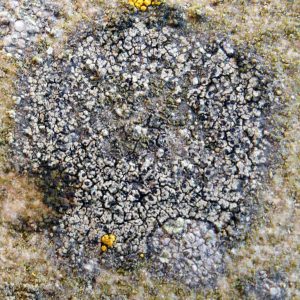A. Fungi
More extensive information on fungi can be found in a separate blog post.
B. Lichens (CALICIACEAE)
The Caliciaceae family consists of 36 genera of lichens, many of which contain just the one species. Other genera within the family have around 300 species. Most members of this family grow on bark, dead wood and rocks.
NOTE: there are perhaps 120 families of lichen species. None of these have an English common name. We have therefore given them all the shared family name of ‘Lichens’. Although this is scientifically incorrect, it is better than saying something like ‘No English family name’. It also enables us to list all lichens on the search page by using this term.
C. Lichen - unnamed 13 (Buellia ocellata)
Buellia ocellata is frequently found, often on smooth sandstones and granite. These lichens are often the first to colonize walls and memorials.
More information on this lichen species can be found on:
Additional Information
Lichens - background information
A lichen is not a single organism, but a collaboration between a fungus and another organism that is able to manufacture nutrients that the fungus cannot. This association is called symbiosis, and the fungus combines with an alga or a cyanobacterium, both of which produce nutrients by photosynthesis. This combination results in a body called a thallus. Each lichen has a unique fungus, whereas some algae and cyanobacteria enter into association with many different fungi, algae being the more common partner of the two. Lichens have different properties to those of the component organisms, and many different structures and colours. Lichens grow on many types of surface, and in a variety of environmental conditions, but are nutritionally self-contained so are not parasitic. When seen growing along the branches of a tree, for example, they are simply using the tree for support. They may be found growing in some of the most extreme habitats on the planet. Their names may be misleading; ‘reindeer moss’ is a lichen, and not related to mosses, which are non-flowering plants.
Lichens have many growth forms of the vegetative body parts, or fungal filaments, collectively called the thallus. These forms are:
- fruticose (tiny, leafless branches)
- foliose (flat, leaf-like structures)
- crustose (crust-like flakes like peeling paint)
- leprose (powdery appearance)
- squamulose (tightly clustered, pebble-like forms)
- filamentous (hair-like)
October 2023 Lichen survey - acknowledgements
We are grateful to Neil Sanderson and Dr. Paul Cannon of the British Lichen Society, who freely gave their time and expertise to conduct a survey of the lichens in Heene Cemetery on 9th October 2023. The species listed here was identified during this survey.
Images
Lichen - unnamed 13 (Buellia ocellata)
Buellia ocellata is frequently found, often on smooth sandstones and granite. These lichens are often the first to colonize walls and memorials.
[Because of the difficulty in photographing these small organisms, we have made an exception to our general rule of only using photographs that have been taken in Heene Cemetery. If and when we manage to take a photograph of this lichen, we will replace this royalty-free, stock image.]
(Photo credit: Paul Cannon, showing "Buellia ocellata, thallus on siliceous gravestone, Bedfordshire, England. Bottom left, C+ orange reaction visible.", Creative Commons License.)






